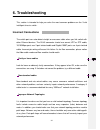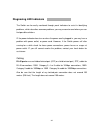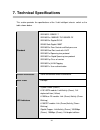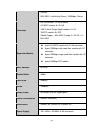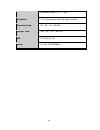- DL manuals
- Lantech
- Switch
- LES-2400-RPS
- User manual
Lantech LES-2400-RPS User manual
Summary of LES-2400-RPS
Page 1
Lantech les-2400-rps 3-slot modularized fast ethernet l2 + 2 gigabit copper / mini-gbic combo managed switch user manual v1.2 apr-2011.
Page 3: Contents
Contents 1. Introduction ...................................................................................................... 1 features ....................................................................................................................... 1 software features ........................
Page 4
Dhcp server .............................................................................................................. 23 tftp ........................................................................................................................... 27 system event log.............................
Page 5: 1. Introduction
1 1. Introduction the 3-slot modularized fast ethernet l2 plus + 2 gigabit copper / mini-gbic combo managed switch is a modular ethernet switch that can be used to build high-performance switched workgroup networks. This switch is a store-and-forward device that offers low latency for high-speed net...
Page 6: Software Features
2 backpressure for half duplex high back-plane bandwidth 8.8gbps supports ieee802.3ad port trunk with lacp broadcast storm filter supported igmp supports for multi media application supports ieee 802.1p class of service port security supported port bandwidth control supported suppo...
Page 7
3 rfc 1215 trap mib rfc 1643 ethernet like rmon1 private mib snmp trap cold/warm start trap, link down/link up trap, authorization fail trap, fan fail trap. Power event trap port trunk supports ieee802.3ad with lacp function. Up to 13 trunk groups, trunk member up to 4 ports and include 2 uplink por...
Page 8
4 bandwidth control per port support ingress rate limiting and egress rate shaping control. The rate limiting and rate shaping can be setting from 0~100mbps 802.1x authentication support ieee802.1x user-authentication and can report to radius server. reject accept authorize disable dhcp dhcp...
Page 9: Package Contents
5 package contents unpack the contents of the 3 -slot intelligent chassis switch and verify them against the checklist below. 3-slot intelligent chassis switch power cord four rubber feet rs-232 cable rack-mounted kit user manual (cd-rom) 3-slot intelligent chassis switch four rubber feet ...
Page 10
6 ethernet switching technology ethernet switching technology dramatically boosted the total bandwidth of a network, eliminated congestion problems inherent with csma/cd (carrier sense multiple access with collision detection) protocol, and greatly reduced unnecessary transmissions. This revolutioni...
Page 11: 2. Hardware Description
7 2. Hardware description this section mainly describes the hardware of the 3-slot intelligent chassis switch, and gives a physical and functional overview of the switch. Physical dimensions the 3-slot intelligent chassis switch physical dimensions are 440mm(w) x 44mm(h) x 280mm(d). Front panel the ...
Page 12: Led Indicators
8 led indicators the led indicators gives real-time information of systematic operation status. The following tables describe definitions for led indicators. Led status description lk/act green the port is connecting with the device. Blinks the port is receiving or transmitting data. Off no device a...
Page 13: Rear Panel
9 rear panel equipped with a 3-pronged power plug for ac power input and a 14-pin dual-row connector for dc power input, the ethernet switch allows users to supply ac power in the range of 100 to 240v/50-60hz or dc power in the range of 12 to 48v for redundant supplying purposes. The rear panel of t...
Page 14: Desktop Installation
10 desktop installation set the switch on a sufficiently large flat space with a power outlet nearby. The surface where you put your switch should be clean, smooth, level and sturdy. Make sure there is enough clearance around the switch to allow attachment of cables, power cord and allow air circula...
Page 15
11 with the smaller bracket screws. Then attach the remaining bracket to the other side of the switch. Attach mounting brackets with screws b. After attaching both mounting brackets, position the switch in the rack by lining up the holes in the brackets with the appropriate holes on the rack. Secure...
Page 16: Power On
12 power on connect the 3-prong ac power cord or the 14-pin 2-row dc power cable to the power socket at the rear panel of the ethernet switch. The ethernet switch can work with ac power in the voltage range of 100-240v/50~60hz or 12-48vdc. The ac and dc inputs can be used for redundant power supply....
Page 17: 3. Network Application
13 3. Network application this section provides you a few samples of network topology in which the switch is used. In general, the 3-slot intelligent chassis switch is designed as a segment switch. That is, with its large mac address table (8k-entry) and high performance, it is ideal for interconnec...
Page 18: Connecting To The Switch
14 connecting to the switch the console port is a female db-9 connector that enables a connection to a pc or terminal for monitoring and configuring the switch. Use the supplied rs-232 cable with a male db-9 connector to connect a terminal or pc to the console port. The console configuration (out of...
Page 19: 4. Console Management
15 4. Console management login in the console interface when the connection between switch and pc is ready, turn on the pc and run a terminal emulation programor hyper terminal and configure its communication parameters to match the following default characteristics of the console port: baud rate: 9...
Page 20: Module Hot-Swapping
16 console login screen module hot-swapping the 3-slot modularized fast ethernet l2 plus + 2 gigabit copper / mini-gbic combo managed switch supports module hot-swapping. User can insert or pull the module out of the slot without powering down the switch. Once the module is not fully inserted, the l...
Page 21: 5. Web-Based Management
17 5. Web-based management this section introduces the configuration and functions of the web-based management. About web-based management inside the cpu board of the switch, there exists an embedded html web site residing in flash memory. It offers advanced management features and allow users to ma...
Page 22: System Login
18 system login 1. Launch the internet explorer on the pc 2. Key in ―http:// ―+‖ the ip address of the switch‖, and then press ―enter‖. 3. The login screen will appear right after 4. Key in the user name and password. The default user name and password are the same as ―root‖ login screen 5. Press ―e...
Page 23: Main Interface
19 main interface main interface.
Page 24: System Information
20 system information here you can view the system information and assign the system name and location to make this switch more easily identified on your network. system name: assign the name of the switch. The maximum length is 64 bytes. system description: a read-only field displaying the desc...
Page 25: Ip Configuration
21 ip configuration dhcp client: enable or disable the dhcp client function. When the dhcp client function is enabled, the industrial switch will be assigned an ip address from the network dhcp server. The default ip address will be replaced by the assigned ip address on dhcp server. After users c...
Page 26
22 ip configuration interface.
Page 27: Dhcp Server
23 dhcp server dhcp is the abbreviation of dynamic host configuration protocol that is a protocol for assigning dynamic ip addresses to devices on a network. With dynamic addressing, a device can have a different ip address every time it connects to the network. In some systems, the device's ip addr...
Page 28
24 system configuration dhcp server: this pull-down menu allows you to configure the switch to be the dhcp server on your local network. low ip address: type in an ip address as the beginning of a range of the dynamic ip address. As the figure shown below, for example, 192.168.16.100 is the rela...
Page 29
25 client entries when the dhcp server function is enabled, the system will collect the dhcp client information including the assigned ip address, the mac address of the client device, the ip assigning type, states and lease time. Dhcp client entries interface.
Page 30
26 port and ip bindings as the figure shown below, the switch will assign the ip address to the connected client according to the port-ip binding table. The user is allowed to fill each port with one particular ip address. When the device is connecting to the port and asks for ip assigning, the syst...
Page 31: Tftp
27 tftp it provides the functions allowing the user to update the switch firmware via the trivial file transfer protocol (tftp) server. Before updating, make sure the tftp server is ready and the firmware image is located on the tftp server. Update firmware tftp server ip address: type in the ip a...
Page 32
28 restore configuration you can restore a previous backup configuration from the tftp server to recover the settings. Before doing that, you must locate the image file on the tftp server first for the switch to download back the flash image. tftp server ip address: type in the ip address of the t...
Page 33
29 backup configuration you can back up the current configuration from flash rom to the tftp server for the purpose of recovering the configuration later. It helps you avoid wasting time on configuring the settings by backing up the entire configuration. tftp server ip address: type in the ip addr...
Page 34: System Event Log
30 system event log this page allows the user to decide whether to send the system event log, and select the mode which the system event log will be sent to client only, server only, or both client and server. What kind of event log will be issued to the client/server depends on the selection on the...
Page 35
31 syslog configuration interface.
Page 36
32 system event log —smtp configuration simple mail transfer protocol (smtp) is the standard for email transmissions across the network. You can configure the smtp server ip address, sender mail account, password, and the recipient email account to which the e-mail alert will send. Besides, this pag...
Page 37
33 smtp configuration interface.
Page 38
34 system event log —event configuration the checkboxes and pull-down menus are not available unless the syslog client mode on the syslog configuration tab and the e-mail alert on the smtp configuration tab are enabled first. This tab mainly controls whether an event notification is to be sent to th...
Page 39
35 event configuration interface.
Page 40: Sntp Configuration
36 sntp configuration sntp (simple network time protocol) is a simplified version of ntp which is an internet protocol used to synchronize the clocks of computers with some time reference. Because time usually just advances, the time on different node stations might be different. With the communicat...
Page 41
37 cst - central standard mdt - mountain daylight -6 hours 6 am mst - mountain standard pdt - pacific daylight -7 hours 5 am pst - pacific standard adt - alaskan daylight -8 hours 4 am ala - alaskan standard -9 hours 3 am haw - hawaiian standard -10 hours 2 am nome, alaska -11 hours 1 am cet - centr...
Page 42
38 jst - japan standard, ussr zone 8 +9 hours 9 pm east - east australian standard gst guam standard, ussr zone 9 +10 hours 10 pm idle - international date line nzst - new zealand standard nzt - new zealand +12 hours midnight sntp sever url: specify the sntp server ip address. You can assign a loc...
Page 43
39 sntp configuration interface.
Page 44: Ip Security
40 ip security ip security function allows the user to assign up to 10 specific ip addresses that have permission to manage the switch through the http and telnet services for securing switch management. The purpose of giving permission to limited ip addresses is to allow only the authorized personn...
Page 45
41 ip security interface.
Page 46: User Authentication
42 user authentication the user authentication interface allows users to configure login user account and password for security reasons. user name: the user account is root by default. Type in the user name field with a new name as you wish. new password: the password to the user account is root...
Page 47: Advanced Configuration
43 advanced configuration broadcast storm filter this tab allows users to enable the broadcast storm filter for the specific packet type. Tick the checkboxes respectively to enable the filters. flooded unicast/multicast packets: when this check box is ticked, the switch will filter the packet type...
Page 48
44 aging time this tab is used to assign the aging time of the mac table. aging time of mac table: set the aging time on off, 150 sec, 300 sec, or 600 sec. When mac table is not used within the aging time, the mac address table will then be cleared. auto flush mac table when link down: when this...
Page 49: Port Statistics
45 port statistics the following chart provides the current statistics information which displays the real-time packet transfer states for each port. The user might use the information to plan and implement the network, or check and find the problem when the collision or heavy traffic occurs. clic...
Page 50: Port Control
46 port control in port control you can configure the settings of each port to control the connection parameters. port: scroll up/down the scroll bar and click on the port number to choose a particular port to be configured. state: enable/disable the port. If the port state is set on ‗disable‘, ...
Page 51
47 port control interface.
Page 52: Port Trunk
48 port trunk port trunking is the combination of several ports or network cables to expand the connection speed beyond the limits of any one single port or network cable. Link aggregation control protocol (lacp), which is a protocol running on layer 2, provides a standardized means in accordance wi...
Page 53
49 the system allows a maximum of four ports to be aggregated in a trunk group. Having configured the parameters above, highlight the ports in the right list box to join the trunk group. Click the add button and the ports highlighted in the right list box will be shifted to the left list box. To r...
Page 54
50 aggregator information when you have set the lacp aggregator, you will see the related information here. Port trunk – aggregator information interface.
Page 55
51 state activity having configured the lacp aggregator on the aggregator setting tab, you may want to change the state activity for the members of the lacp trunk group. You can tick/untick the checkbox beside the state label. If you remove the tick mark of the corresponding port and click the apply...
Page 56: Port Mirroring
52 port mirroring port mirroring is a method for monitoring of network traffic on switched networks. Traffic through ports can be monitored by one specific port, which means traffic going in or out the monitored (source) ports will be duplicated into the analysis (mirroring) port. mode: select the...
Page 57: Rate Limiting
53 rate limiting you can respectively configure the ingress/egress rate for each port. Rate limiting interface all the ports support packet ingress and egress rate control. inrate: enter the port effective ingress rate (the default value is ―0‖). outrate: enter the port effective egress rate (...
Page 58: Vlan Configuration
54 vlan configuration a virtual lan (vlan) is a logical network grouping that limits the broadcast domain, which allows you to isolate network traffic. Therefore only the members of the same vlan will receive traffic from the ones among the same vlan. Basically, creating a vlan on a switch is logica...
Page 59
55 vlan – port based interface click add to create a new vlan group (the vlan groups can be up to 64). Vlan —port based add interface enter the group name and vlan id. Select the port number available in the left list.
Page 60
56 box, and click the add button to move the highlighted ports to the right list box. Or you can select any of the ports listed in the right field and click remove to remove port(s) from the vlan. when finished, click apply to have the vlan configuration take effect. and then you will see the vl...
Page 61
57 802.1q vlan when the vlan operation mode is set on 802.1q, all ports on the switch belong to the default vlan of vid 1, which means they logically are regarded as members of the same broadcast domain. The valid vlan id is in the range of number between 1 and 4094. The amount of vlan groups is up ...
Page 62
58 after you have configured the three parameters, click the apply button right beneath this area to finish creating an 802.1q vlan. 802.1q vlan interface on the 802.1q configuration tab, click the port pull-down menu to select a port you want to configure within the vlan. link type: three opt...
Page 63
59 untagged frame gets into the access port, the switch inserts a four-byte tag in the frame. The contents of the last 12-bit of the tag is the untagged vid. When this frame is sent out through any of the access ports of the same pvid, the switch will remove the tag from the frame to recover it to w...
Page 64
60 access link and hybrid link. Assign a number in the range between 1 and 4094. tagged vid: this field is available when the link type pull-down menu is set on trunk link and hybrid link. Assign a number in the range between 1 and 4094. click the apply button on the tab to have the port configu...
Page 65
61 group configuration interface when finished, click apply to have the modification take effect..
Page 66: Rapid Spanning Tree
62 rapid spanning tree the rapid spanning tree protocol (rstp) is an evolution of the spanning tree protocol providing for faster spanning tree convergence after a topology change. The system also supports stp and will auto-detect the connected device running stp or rstp. Rstp system configuration t...
Page 67
63 bridge id: this field displays the bridge id by showing the mac address of this switch. root priority: this field displays the numerical value indicating bridge priority of the switch. Generally, the switch with the lowest numerical value in the network is set as the root bridge. root port:...
Page 68
64 port configuration this tab offers the interface for rstp port configuration where you can assign parameters to each port. The rapid spanning tree protocol will have the port with the higher priority in forwarding state and block other ports to make certain that there is no loop in the lan. scr...
Page 69
65 rstp port configuration interface.
Page 70: Pro-Ring System
66 pro-ring system x-ring provides a faster redundant recovery than spanning tree topology. The action is similar to stp or rstp, but the algorithms not the same. In the x-ring topology, every switch should enable x-ring function and assign two member ports in the ring. Only one switch in the x-ring...
Page 71
67 enable coupling ring: to enable the coupling ring function. Marking the check box to enable the coupling ring function. coupling port: assign the member port. control port: set the switch as the master switch in the coupling ring. enable dual homing: set up one of port on the switch to be...
Page 72: Snmp Configuration
68 snmp configuration simple network management protocol (snmp) is the protocol developed to manage nodes (servers, workstations, routers, switches and hubs etc.) on an ip network. Snmp enables network administrators to manage network performance, find and solve network problems, and plan for networ...
Page 73
69 snmp system configuration interface.
Page 74
70 trap configuration a trap manager is a management station that receives trap messages generated by the switch. If no trap manager is defined, no traps will be issued. To define a management station as a trap manager, assign an ip address, enter the snmp community strings, and select the snmp trap...
Page 75
71 snmpv3 configuration this tab allows users to configure the snmpv3 settings for communications via snmpv3. Context table configure the snmpv3 context table. Assign the context name in the field. Click apply to add the context name added or changed. User table configure the snmpv3 user table. us...
Page 76
72 snmp v3 configuration interface access table configure the snmpv3 access table..
Page 77
73 context prefix: in this filed type in the prefix letters of the context name that is assigned in the context table. group name: type in the group name that is assigned in the group table. security level: select a radio button to determine which security level is assigned to the group. The o...
Page 78: Qos Configuration
74 qos configuration you can configure qos mode, 802.1p priority [7-0] setting, static port ingress priority setting and tos setting. qos mode: click the pull-down menu to select the qos policy rule. disable qos priority: the default status of qos priority is disabled. high empty then low: whe...
Page 79
75 qos configuration interface.
Page 80: Igmp Configuration
76 igmp configuration igmp is the protocol used by ipv4 systems to report their ip multicast group memberships to neighboring multicast routers. Igmpv3 adds support for "source filtering", that is, the ability for a system to report interest in receiving packets only from specific source addresses, ...
Page 81
77 igmp configuration interface.
Page 82: Lldp
78 lldp link layer discovery protocol (lldp), a one way protocol, specified in the ieee 802.1ab standard allows stations attached to the same ieee 802 lan to advertise their information to neighbors and store the information received from adjacent stations. Receivers on the same physical lan will st...
Page 83: 802.1X/radius
79 802.1x/radius 802.1x is an ieee authentication specification that allows a client to connect to a wireless access point or wired switch but prevents the client from gaining access to the internet until it provides authority, like a user name and password that are verified by a separate server. Sy...
Page 84
80 port configuration you can configure 802.1x authentication state for each port. The state provides disable, accept, reject and authorize. Use ―space‖key to change the state value. reject: the specified port is required to be held in the unauthorized state. accept: the specified port is requir...
Page 85
81 misc configuration quiet period: set the period during which the port doesn‘t try to acquire a supplicant. tx period: set the period the port waits for retransmitting the next eapol pdu during an authentication session. supplicant timeout: set the period of time the switch waits for a suppl...
Page 86: Mac Address Table
82 mac address table the mac address table interface allows users to configure static mac addresses, mac filtering, multicast filtering and provides information of all mac addresses on each port. Static mac address you can add a static mac address that remains in the switch's address table regardles...
Page 87
83 mac filtering by filtering mac address, the switch can easily filter pre-configured mac addresses and reduce the un-safety. You can add or delete filtering mac addresses. Mac filtering interface mac address: enter the mac address to be filtered. vlan id: type in the vlan group id the mac addr...
Page 88
84 all mac addresses this tab displays all mac address entries learned or set. All mac address interface port no: click the pull-down menu to select a particular port to show its information. current mac address: information of the selected port will be displayed in this field. click the clear...
Page 89
85 multicast filtering similar to broadcasts, multicasts are sent to all end stations on a lan or vlan. Multicasting filtering is the function which end stations can receive the multicast traffic if the connected ports had been included in the specific multicast groups. With multicast filtering, net...
Page 90: Access Control List
86 access control list the switch provides a 256-entry access control list (acl) to check ipv4/non-ipv4 addresses and tcp/udp port numbers of packets. group id: type in the group id from 1 to 255 for the access control list being configured. action: click the pull-down menu to selectpermit or de...
Page 91
87 access control list interface.
Page 92: Factory Default
88 factory default click the reset button to reset the switch back to factory defaults. Before resetting, you can tick the checkboxes to keep the current ip address and user name/password. Factory default interface.
Page 93: Save Configuration
89 save configuration save all changes you have made in the system. To ensure the configurations you have made will be implemented the next time you power on the switch, remember to click the save button to save the all configurations into the flash memory. Save configuration interface.
Page 94: System Reboot
90 system reboot reboot the switch under software control. Click the reboot button to restart the system. System reboot interface.
Page 95: 6. Troubleshooting
91 6. Troubleshooting this section is intended to help you solve the most common problems on the 3-slot intelligent chassis switch. Incorrect connections the switch port can auto-detect straight or crossover cable when you link switch with other ethernet devices. The rj-45 connector should use corre...
Page 96: Diagnosing Led Indicators
92 diagnosing led indicators the switch can be easily monitored through panel indicators to assist in identifying problems, which describes common problems you may encounter and where you can find possible solutions. If the power indicator does turn on when the power cord is plugged in, you may have...
Page 97: 7. Technical Specifications
93 7. Technical specifications this section provides the specifications of the 3-slot intelligent chassis switch as the table shown below. Standard ieee802.3 10base-t ieee802.3u 100base-tx/100base-fx ieee802.3z gigabit sx/lx iee802.3ab gigabit 1000t ieee802.3x flow control and back pressure ieee802....
Page 98
94 (yellow) mini gbic: link/activity(green), 1000mbps (green) connector rs-232 console: 1 x db-9 female 10/100tx module: 8 x rj-45 100fx (multi /single mode) module: 8 x sc 100sfp module: 8 x sfp gigabit copper + mini-gbic combo: 2 x rj-45 + 2 x mini-gbic expansion module 8 port 10/100tx module wi...
Page 99
95 redundant power: dc 12 ~ 48v ventilation 2 x dc cooling fans with auto-detect function operating temp. -0℃~45℃, 5%~95%rh storage temp. -40℃~70℃, 5% ~ 95% rh emi fcc class a, ce safety ul, cul, ce/en60950-1.































































































